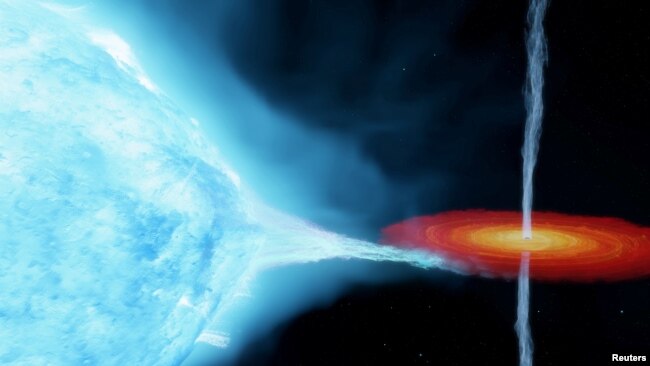ブラックホール、それは予想外に大きい
最近の研究では、宇宙は収縮しているのではなく、膨張しているのだそうです。ではその中で今回あるように、予想以上に大きかったブラックホール、膨張したらどうなるのかしら?
分からないことは、想像を膨張させる~~~
数字ゴロゴロで、頭クラクラ
今日のVOAニュース、宇宙の神秘に迫ります。
- 新研究:ブラックホールは予想以上に大きいかもしれない
- 英語の小窓
- New Study: Black Hole May Be Larger Than Expected
- Words in This Story
新研究:ブラックホールは予想以上に大きいかもしれない
New Study: Black Hole May Be Larger Than Expected
2 hours ago /February 28, 2021
 FILE - 地球から約7,200光年の距離にある伴星の周りを周回している、いわゆる恒星質量ブラックホールを持つ「はくちょう座X-1星系」の画像。(国際電波天文学研究センター/Handout via REUTERS)
FILE - 地球から約7,200光年の距離にある伴星の周りを周回している、いわゆる恒星質量ブラックホールを持つ「はくちょう座X-1星系」の画像。(国際電波天文学研究センター/Handout via REUTERS)
最近の研究で、これまでに発見された最初のブラックホールは、科学者が最初に考えていたよりもずっと大きいことがわかりました。
ブラックホールは非常に巨大な宇宙空間の物体で、その重力は非常に強力で、光さえも逃がしません。ブラックホール、Cygnus 白鳥座X-1は1964年に発見されました。このブラックホールは、2人の有名な科学者の間で友好的な賭けの対象となったことでよく知られています。
研究者たちは、はくちょう座X-1が太陽の21倍の質量を持っていることを発見しました。これは、科学者たちが信じていたよりも約50パーセント以上の質量を持っているということです。
シグナスX-1は依然として知られている最も近いブラックホールの一つですが、科学者達は以前の予想よりも遠くにあることを発見しました。その距離は7,200光年。光年とは、光が1年で移動する距離のことです。
天の川銀河の中心にあるブラックホールのように、非常に大きなブラックホールもあります。これらは ”超巨大” ブラックホールと呼ばれています。太陽の何百万倍もの大きさになることもあります。これより小さいブラックホールは、”恒星質量”ブラックホールと呼ばれています。これらのブラックホールは、単一の星の質量を持っています。
Cygnus はくちょう座X-1は、天の川銀河で最大の恒星質量を持つブラックホールとして知られています。カーティン大学とオーストラリアの国際電波天文学研究センターのジェームズ・ミラー・ジョーンズ氏は、地球から見られる最も強力なX線源の一つであると述べています。ミラー-ジョーンズは、出版物 Scienceサイエンスに掲載された研究を主導しました。
Cygnus白鳥座X-1は、物理学者アルバート・アインシュタインのgeneral relativity一般相対性理論の下で予測された最高の速度に近づいて速く回転している、とミラー・ジョーンズ氏は付け加えています。
ブラックホールは、それが公転する星の表面から来る物質を持ち込みます。この星は “blue supergiant” ”青い超巨星”と呼ばれる非常に大きな星で、太陽の約40倍の質量を持ちます。
白鳥座X-1は、400万〜500万年前に太陽の75倍の質量を持つ星として存在し始めました。しかし、数万年前にブラックホールに崩壊してしまいました。
今回の研究では、電波望遠鏡 超長基線アレー のデータを用いています。米国内の10の観測局で構成されています。
白鳥座X-1が最初にブラックホールの可能性があると特定された後、スティーブン・ホーキング博士とキップ・ソーンという2人の物理学者の間で友好的な賭けが行われました。ホーキング博士はこの天体がブラックホールであることに反対し、ソーン博士はブラックホールであることに賭けました。ホーキング博士は最終的に、白鳥座X-1がブラックホールであることを示唆する証拠があることを認めました。
最近の研究のリーダーであるミラー・ジョーンズ氏は、「確かに、私はこれらの発見に乗って賭けをしたことはありません。」と述べています。
英語の小窓
数字表現が多かったので、ちょっと記載。
何倍の表現
40 times :40倍
では、何十倍は?
答えは: tens of times
ココデの表現は
millions of times:何百万倍
a few tens of thousands :数万年
※tens of thousands :何万もの
ex.
Tens of thousands of people came into the baseball studium.
何万もの観客が野球場に詰めかけました。
何度も練習して、口からついて出るようにしなきゃ、です、ハイ
(^^♪
New Study: Black Hole May Be Larger Than Expected
 FILE - An artist's impression of the Cygnus X-1 system, with a so-called stellar-mass black hole orbiting a companion star some 7,200 light years from Earth. (International Centre for Radio Astronomy Research/Handout via REUTERS
FILE - An artist's impression of the Cygnus X-1 system, with a so-called stellar-mass black hole orbiting a companion star some 7,200 light years from Earth. (International Centre for Radio Astronomy Research/Handout via REUTERS
A recent study found that the first black hole ever discovered is a lot bigger than scientists first thought.
Black holes are extremely massive space objects whose gravity is so powerful not even light escapes. The black hole, Cygnus X-1, was discovered in 1964. It is well-known for being the object of a friendly bet between two famous scientists.
Researchers found that new observations of Cygnus X-1 showed it is 21 times our sun’s mass. That is about 50 percent more massive than scientists had believed.
While it is still one of the closest black holes known, the scientists found it is farther away than earlier estimates suggested. It is 7,200 light years away. A light year is the distance light travels in one year.
Some black holes, like the one at the center of the Milky Way Galaxy, are extremely large. These are called “supermassive” black holes. They can be millions of times more massive than the sun. Smaller black holes are called “stellar-mass” black holes. They have the mass of a single star.
Cygnus X-1 is the Milky Way’s largest-known stellar-mass black hole. It is among the strongest X-ray sources seen from Earth, said James Miller-Jones of Curtin University and the International Centre for Radio Astronomy Research in Australia. Miller-Jones led the study that appeared in the publication Science.
Cygnus X-1 turns so quickly that it comes close to the highest rate predicted under physicist Albert Einstein’s theory of general relativity, Miller-Jones added.
The black hole brings in material that comes from the surface of the star that it orbits. This star is a “blue supergiant,” a very large star about 40 times our sun’s mass.
Cygnus X-1 started to exist 4 million to 5 million years ago as a star up to 75 times more massive than the sun. But then it collapsed into a black hole a few tens of thousands of years ago.
The research included data from the Very Long Baseline Array radio telescope. It is made up of 10 observation stations in the United States.
After Cygnus X-1 was first identified as a possible black hole, a friendly bet was made between two physicists, Stephen Hawking and Kip Thorne. Hawking bet against the object being a black hole, while Thorne bet that it was one. Hawking eventually admitted that the evidence suggested Cygnus X-1 was a black hole.
Miller-Jones, the leader of the recent study said, “Indeed, I did not have any wagers riding on these findings.”
_____________________________________________________________
Words in This Story
bet – n. an agreement in which people try to guess what will happen and the person who guesses wrong has to give something (such as money) to the person who guesses right; a wager
source – n. the place where something starts from
wager – n. an agreement in which people try to guess what will happen and the person who guesses wrong has to give something (such as money) to the person who guesses right; a bet